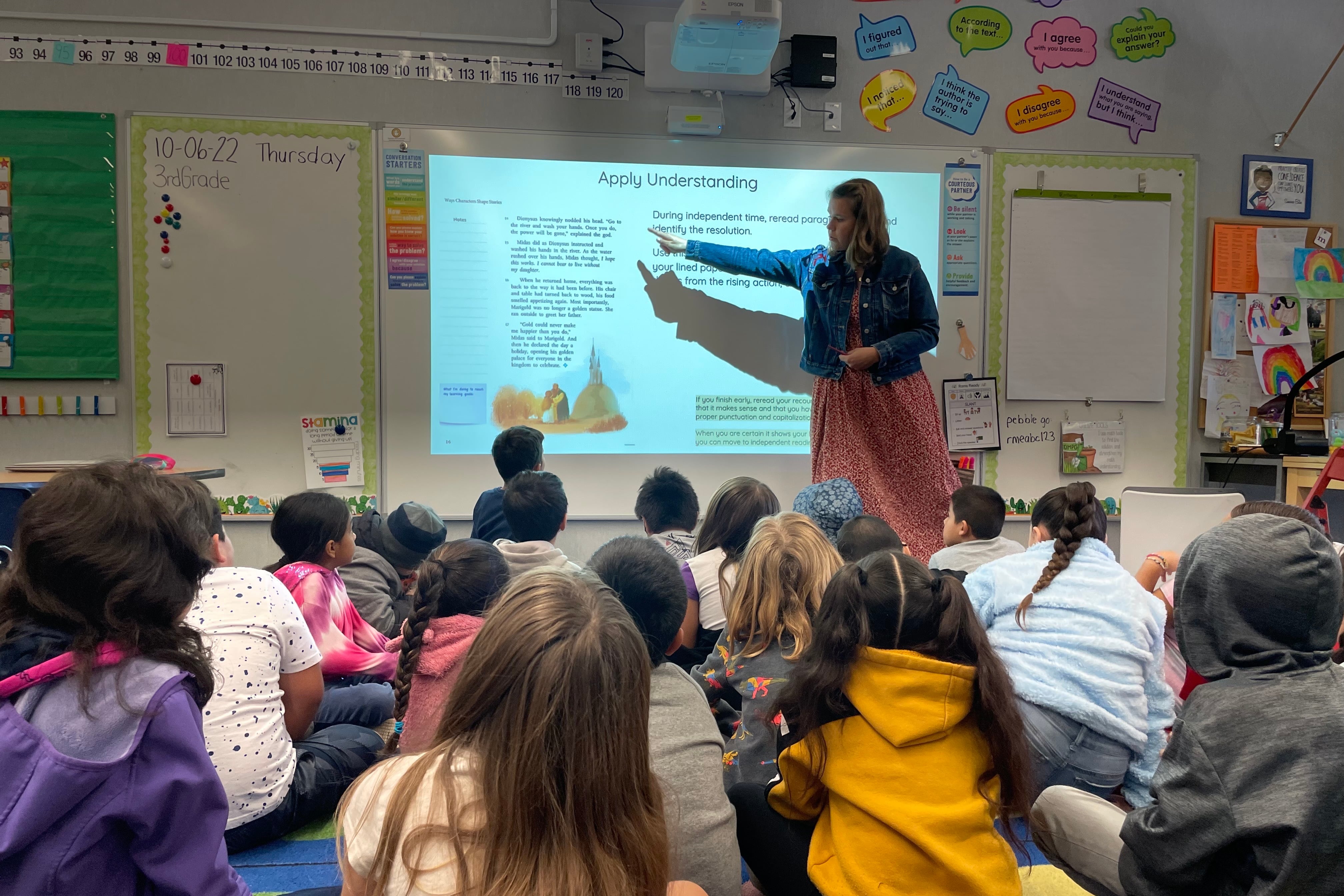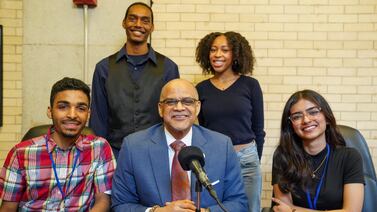Sign up for Chalkbeat Colorado’s free daily newsletter to keep up with education news from Denver and around the state.
State test scores released Thursday show signs that Colorado students are recovering from pandemic learning disruption, as 2023 scores approached 2019 levels in some grades and subjects.
But worrying signs remain that many students are still struggling.
The share of fourth and eighth graders who could read and write at or above grade level on CMAS tests taken this past spring remains more than 4 percentage points behind the share who could in 2019. Seventh and eighth graders are similarly behind in math. Each percentage point represents thousands of students who are not meeting expectations and who are less prepared for the next grade.
At the same time, fifth and sixth graders are posting similar scores in reading and writing to their peers four years ago, and in math, all elementary students are. At nearly every grade level, more students met or exceeded expectations in both language arts and math in 2023 than did in 2022, with fifth and seventh graders improving several percentage points in reading.
State education officials attribute the progress to a more normal school year, with fewer disruptions due to illness and safety protocols, as well as to school districts’ investments in new curriculum and tutoring to help students catch up. At the same time, staff shortages meant educators had less time to help struggling students, and many schools reported increases in students missing class.
The uneven recovery may be due to differences in where students were developmentally when COVID hit and school moved online — and how critical the material they missed during disrupted schooling was to the next grade level. Students who were in eighth grade in spring 2023 were in fifth grade when schools shut down in March 2020.
“There are some key learnings that typically occur in some grade levels that have impact down the road,” Joyce Zurkowski, chief assessment officer for the Colorado Department of Education, said on a call with reporters this week.
She said education officials consider “what typically is covered (in) fifth grade, second semester — and how that could be impacting our students in seventh and eighth grade.”
All Colorado students in grades three through eight take reading, writing, and math tests every spring. The tests are known as the Colorado Measures of Academic Success, or CMAS. Some students also take tests in science and social studies. High schoolers take the PSAT and SAT.
Scores for English learners raise concerns
Test scores for English learners and students who took the reading and writing tests in Spanish raise major concerns about how well these children are faring in school.
Just 18.7% of third graders who took the test in Spanish met or exceeded expectations, down 8.8 percentage points from 2019 — by far the biggest lag in student recovery. And just 14.2% of fourth graders who took the Spanish test met or exceeded expectations, down almost 5 percentage points from 2019.
State education officials said the trend calls for more attention to these students. Some of that will have to come from state lawmakers, who have set aside money and crafted new rules to support reading and math instruction, but not bilingual learners.
Floyd Cobb, the associate commissioner of student learning, made that clear this week. Asked what the state education department will do to close the gap between bilingual learners and English-speaking students, he said, “that’ll need to be answered by the General Assembly.”
“Our job here at the department is to make sure that we go about implementing the laws that the General Assembly passes, and in the event that someone writes a bill, and that bill makes it through, we’ll engage in our work to be able to support,” Cobb said.
Colorado’s Latino communities suffered a heavy toll during the pandemic, experiencing more illness and death, more job losses, and more economic instability than white Coloradans. Hispanic families are also less likely to have reliable internet access, and have been affected by rising rents and home prices that have pushed many of them out of their neighborhoods.
Colorado education officials are also watching with concern the test scores of middle school girls. Girls typically do better than boys in language arts, while boys do better in math. That hasn’t changed, but in some cases, gender gaps have narrowed because girls are doing worse. The number of eighth grade girls meeting or exceeding expectations in language arts is down 7.7 percentage points since 2019, and down more than 3 points just since last year.
“When we look at the national level, there’s been significant research that suggests young women have struggled more during the pandemic with depression and anxiety,” Colorado Commissioner of Education Susana Córdova said.
“It’s hard to say if that’s the reason why we’re seeing lower performance with young women than we are with young men,” Córdova said. “But I think it’s going to be important for us to continue to monitor and look at and to focus supports on young women.”
Colorado continues to have major gaps in proficiency rates based on student race and economic status. The share of white and Asian students scoring at grade level is 24 to 30 points higher than for Black and Hispanic students. The gaps between students living in poverty — as measured by eligibility for free- or reduced-price lunch — and their more affluent peers is more than 30 points in most grades and subjects.
These are longstanding problems, but Colorado education officials said they demand urgent attention.
How state officials, schools, teachers, and families use CMAS results
Critics of standardized tests say they are a better measure of the effects of poverty than of academic performance, but state education officials point out that they are the only statewide measure of how well students meet the state’s academic standards.
The state uses the test results to rate schools and districts, and to direct help to schools with lower scores and issue state improvement orders.
Parents can use their children’s individual test results to discuss strengths and weaknesses with teachers, and they can use state data to see how their school and district perform compared with others.
Schools and teachers can use the test scores to determine the subjects where students are furthest behind and find ways to help them improve.
In addition to the raw test scores, Colorado also calculates growth scores. Those scores measure how much progress students made compared with students who scored similarly to them the year before and are generally considered a better measure of the work educators do than raw test scores.
Because of the way the growth scores are calculated, the state average is always around 50 on a 100-point scale. Students who are behind need growth scores above 50 to catch up.
In the aftermath of the pandemic, Colorado students would need growth scores of 55 or higher to catch up to 2019 achievement levels, said Lisa Medler, the executive director of accountability and continuous improvement for the Colorado Department of Education.
Among districts with more than 1,000 students that serve a large portion of students of color, only Denver edged above 50 in growth in both language arts and math, and many districts had below-average growth scores.
Statewide, district growth scores for grades three through eight ranged from a high of 79 in math in Hinsdale County RE-1, a small district in southwest Colorado, to a low of 23, also in math, in Agate School District #300, a tiny district in the east.
Denver scores rebound, but big gaps remain
In Denver Public Schools, Colorado’s largest school district with nearly 88,000 students, test scores for most grades and subjects rebounded, but not quite to pre-pandemic levels.
There were a few exceptions. Third graders scored higher this past spring than four years ago: 40% met or exceeded expectations in 2023, compared with 39% in 2019.
The troubling trend of English learners falling further behind showed up in Denver’s test scores, too. Most English learners in Denver speak Spanish, and more than 1,600 Denver students took the state literacy test in Spanish. But only 21% met or exceeded expectations on the Spanish literacy test, down from 29% in 2019.
While English-speaking students are catching up from pandemic learning loss, students who are still learning the English language are not, the test data shows. The test score gap between English learners and English speakers is growing.
Denver has other gaps, too. Last year, Denver’s test score gaps between white and Black students, and between white and Hispanic students, were the biggest in Colorado. The gaps did not shrink this year. In fact, the gap grew in math between white and Hispanic students.
Denver Superintendent Alex Marrero has said he wants to see the number of students scoring at grade level go up by 10 percentage points in reading and math by 2026 — a goal he included in the district’s strategic plan. The plan says test scores should improve even more for “some student groups,” an acknowledgement that Denver has big gaps to close.
This year’s test scores show only slight progress toward that goal. Proficiency rates in grades three through seven rose between 0.2 and 2.4 percentage points, depending on the grade. Eighth graders declined slightly in language arts.
On both the PSAT and SAT, fewer Denver students scored at or above a benchmark meant to indicate college readiness this past spring in literacy and math than did in 2019.
Adams 14 test scores remain low
The Adams 14 school district, which received state orders to reorganize after years of chronic low student performance, continued to see low scores.
At the high school level, students in every grade level tested had lower average combined scores than in 2019. The trend is similar statewide, but Adams 14’s scores are lower than the state’s average.
In grades three through eight, Adams 14 saw significantly lower scores districtwide compared with 2019, nearly across the board.
The biggest decrease was among fifth graders taking English language arts tests, only 12.7% of whom met or exceeded expectations. The only districtwide improvement was very small: just a 0.1 percentage point increase among sixth graders in math. Only 4.3% of those students met or exceeded expectations.
Looking at growth among Adams 14 students, the district and most of its schools had growth scores of less than 50. The two highest growth scores were for math at Dupont, with a 57.5, and language arts at Rose Hill Elementary which had a growth score of 58.
The test where Adams 14 had its highest percentage of students meeting expectations was on the language arts tests given in Spanish. Among third graders taking that test, for instance, 19.2% of students met or exceeded expectations, compared with 17.6% of third graders taking that test in English.
Adams 14 has one of the state’s highest proportions of students learning English as a second language, and historically has had trouble educating those students and complying with their civil rights. In more recent years, the district has implemented bilingual programming and created a plan that finally got federal approval for how to educate English learners.
Third graders still recovering in reading
Elementary students are still not yet up to pre-pandemic reading proficiency levels, despite big changes in how Colorado schools teach reading.
Statewide, 39.9% of the spring’s third graders met or exceeded expectations on reading tests. That percentage is lower than last year, and down from 41.3% in 2019.
Sheridan, Douglas County, Jeffco, and St. Vrain districts in the metro area showed significant improvements in third grade reading.
In Sheridan, the district went from having just over 10% of students meet expectations for reading in 2019 to 26.8% this spring. In the Douglas County school district, 58% of third graders met expectations in reading, up from 52% in 2019. The score put the Dougco district above most metro area districts.
The Jeffco school district also had increases, with 48.2% of third graders meeting reading standards, up from 46.3% in 2019.
Mapleton and Pueblo 60 districts have not been able to bring the percentage of students meeting expectations back up to 2019 levels. In Mapleton, 17.8% of third grade students met or exceeded reading expectations this spring, down from 28.1% in 2019. In Pueblo 60, 22.9% of third grade students met or exceeded reading expectations, down from 27.6% in 2019.
Among 10 districts that serve the highest percentages of students of color and have more than 1,000 students, all saw a decrease in the percentage of students meeting expectations in math. Westminster and East Otero in southeast Colorado had the smallest decreases in overall math scores. Among Westminster students 15.5% met or exceeded expectations in math this year, down from 16.4% of students in 2019.
Bureau Chief Erica Meltzer covers education policy and politics and oversees Chalkbeat Colorado’s education coverage. Contact Erica at emeltzer@chalkbeat.org.
Melanie Asmar is a senior reporter for Chalkbeat Colorado, covering Denver Public Schools. Contact Melanie at masmar@chalkbeat.org.
Yesenia Robles is a reporter for Chalkbeat Colorado covering K-12 school districts and multilingual education. Contact Yesenia at yrobles@chalkbeat.org.








